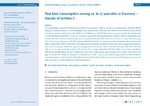Fast food consumption among 12- to 17-year-olds in Germany –
Results of EsKiMo II
Moosburger, Ramona
Lage Barbosa, Clarissa
Haftenberger, Marjolein
Brettschneider, Anna-Kristin
Lehmann, Franziska
Kroke, Anja
Mensink, Gert B. M.
Consuming high amounts of fast food can lead to an excessive intake of energy and subsequently promote obesity.
Obesity increases a person’s risk for diabetes and cardiovascular diseases. The second wave of the German Health
Interview and Examination Survey for Children and Adolescents (KiGGS Wave 2, 2014–2017) included the Eating study
as a KiGGS Module (EsKiMo II, 2015–2017) which assessed the self-reported dietary habits of children and adolescents
in Germany. The analysis of the data permits an overview of the fast food consumption of 12- to 17-year-olds (n=1,353).
Girls consume 57.5 grams and boys 86.3 grams of fast food per day on average (around 400 grams and 600 grams per
week, respectively). Pizza is the most consumed fast food product, followed by filled pita and sausage/meat products
such as curry sausage. Adolescent girls on average get 6.5% and boys 7.8% of total daily energy intake from fast food.
23% of 12- to 17-year-olds get at least 10% of their daily energy intake from fast food (high consumers). Significant
differences between the proportion of high consumers exist regarding sex, age, socioeconomic status, community size,
type of school and media consumption. Compared to EsKiMo I (2006), girls’ daily energy intake from fast food has
remained nearly constant, whereas that of boys has dropped substantially. From a nutrition physiology perspective, the
aim should be to further reduce fast food consumption.
Files in this item
No license information

